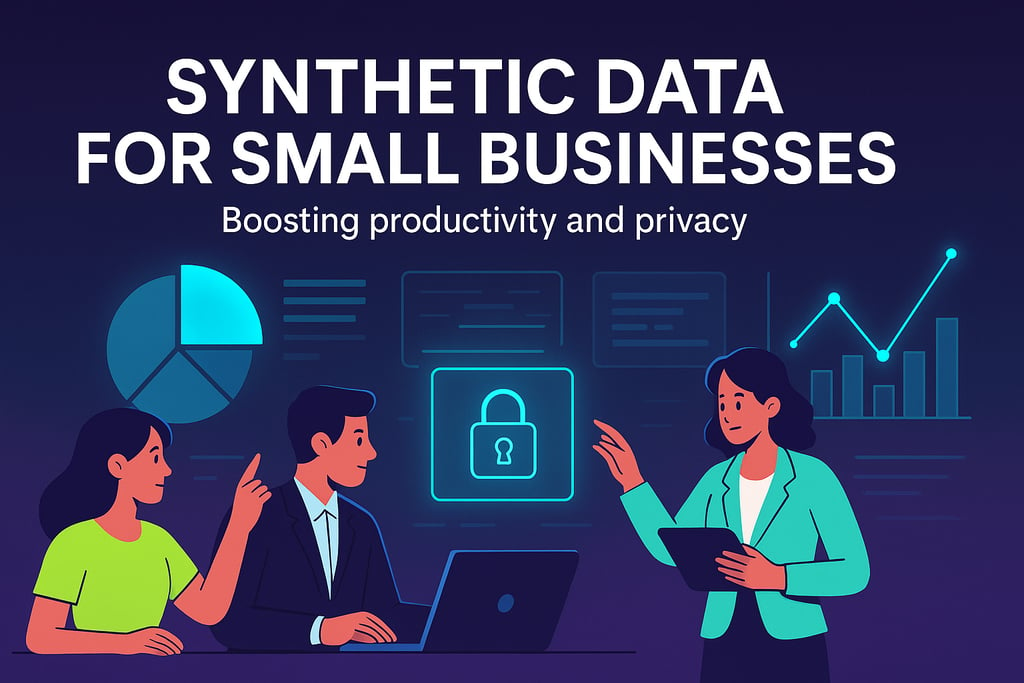Synthetic Data Simplified: How Small Businesses Can Boost Productivity and Privacy Without Big Data Budgets
Discover how your small business can leverage synthetic data, an accessible, privacy-conscious approach to enhance productivity, scenario planning, and employee performance, all without breaking your budget or needing advanced analytics skills.
PERFORMANCEI/O PSYCHOLOGYDATA ANALYTICS
Jess Sumerak
5/13/20252 min read


What is Synthetic Data
Synthetic data is artificially generated information designed to replicate real-world data statistically without compromising privacy. It's especially beneficial for businesses with privacy concerns or limited access to extensive real-world data.
Benefits of Using Synthetic Data in Your Business
Integrating synthetic data generation into your business strategy offers significant advantages, particularly for small to mid-sized teams:
Enhanced Privacy Protection: Synthetic data mimics real behaviors without compromising individual privacy, ensuring confidentiality and compliance.
Cost-Efficient Insights: Generate realistic data without the high costs associated with extensive surveys or data collection.
Scenario Testing & Risk Reduction: Safely test management strategies and workflow changes without real-world risks.
Improved Decision-Making: Identify actionable insights like productivity correlations easily and clearly.
Accessibility & Simplicity: Leverage simple tools (Excel, open-source software) to apply powerful behavioral analytics without needing advanced skills.
Ethical Alignment & Transparency: Embrace ethical workplace practices by choosing a transparent and privacy-conscious data approach.
Potential Drawbacks and Concerns
Quality and Realism: Risk of oversimplifying real-world complexities.
Bias and Representation Issues: Potential introduction or amplification of biases.
Dependence on Generation Model: Outcomes depend heavily on initial assumptions.
Misinterpretation Risks: Misapplication or misunderstanding can occur without proper understanding.
Limited Regulatory Acceptance: Skepticism from regulatory frameworks and auditors in certain industries.
Complexity: Advanced methods (GANs, ABMs) can require substantial expertise.
How Small Businesses Can Create Synthetic Data
Step 1: Define Your Goals Clearly
Identify behaviors or outcomes for improvement: teamwork, collaboration, productivity, etc.
Step 2: Identify Key Factors
Define measurable factors such as productivity indicators, collaboration frequency, and employee satisfaction.
Step 3: Generate Base Data
Use existing internal records or hypothetical baseline scenarios if data is limited.
Step 4: Choose Simple Statistical Tools
Utilize basic tools like Excel or beginner-friendly software (Jamovi, JASP).
Step 5: Apply Simple Bootstrapping Techniques
Resample and alter existing data to simulate broader scenarios.
Step 6: Utilize Agent-Based Thinking
Create "employee personas" to simulate realistic interactions and scenarios.
Step 7: Iterative Improvement
Regularly update scenarios to improve realism and utility.
Practical Applications for Small Businesses
Scenario Planning and Workflow Testing: Simulate scenarios like workload increases or remote collaboration.
Training & Development: Conduct training exercises without exposing sensitive information.
Employee Performance Insights: Identify strengths and opportunities for improvement.
Privacy-Sensitive Analysis: Gain insights without handling sensitive data.
Tools and Resources for Easy Implementation
Excel or Google Sheets: Simple data modeling.
Open-source tools: JASP, Jamovi, Orange.
Online Resources: Tutorials from Coursera, Udemy, or YouTube.
Further Research and Reading
Advancing Employee Behavior Analysis through Synthetic Data: Jayashankar & Balan, 2024
Comprehensive Exploration of Synthetic Data Generation: Bauer et al., 2024
Attention-Based Synthetic Data Generation: Kuo et al., 2025
Machine Learning for Synthetic Data Generation: Lu et al., 2023
Best Practices and Lessons Learned on Synthetic Data: Liu et al., 2024
These studies emphasize the growing importance and practical applications of synthetic data, making it highly beneficial for businesses aiming to leverage data-driven strategies responsibly and effectively.
Intentional Empowerment, LLC
Empowering people-first, Research based, business strategy & employee well-being
© 2025 Intentional Empowerment. All rights reserved.
Follow us on social
Have a question? We're here to help.
📧 jessicasumerak@gmail.com
📍 Twinsburg, OH (Serving clients nationwide)
